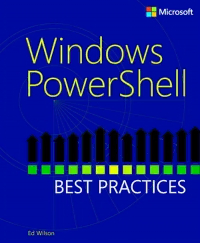Table Of ContentWindows PowerShell
Best Practices
Ed Wilson
Published with the authorization of Microsoft Corporation by:
O’Reilly Media, Inc.
1005 Gravenstein Highway North
Sebastopol, California 95472
Copyright © 2013 by Ed Wilson
All rights reserved. No part of the contents of this book may be reproduced
or transmitted in any form or by any means without the written permission of
the publisher.
ISBN: 978-0-7356-6649-8
1 2 3 4 5 6 7 8 9 LSI 8 7 6 5 4 3
Printed and bound in the United States of America.
Microsoft Press books are available through booksellers and distributors
worldwide. If you need support related to this book, email Microsoft Press
Book Support at mspinput@microsoft.com. Please tell us what you think of
this book at http://www.microsoft.com/learning/booksurvey.
Microsoft and the trademarks listed at http://www.microsoft.com/about/legal/
en/us/IntellectualProperty/Trademarks/EN-US.aspx are trademarks of the
Microsoft group of companies. All other marks are property of their respec-
tive owners.
The example companies, organizations, products, domain names, email ad-
dresses, logos, people, places, and events depicted herein are fictitious. No
association with any real company, organization, product, domain name,
email address, logo, person, place, or event is intended or should be inferred.
This book expresses the author’s views and opinions. The information con-
tained in this book is provided without any express, statutory, or implied
warranties. Neither the authors, O’Reilly Media, Inc., Microsoft Corporation,
nor its resellers, or distributors will be held liable for any damages caused or
alleged to be caused either directly or indirectly by this book.
Acquisitions and Developmental Editor: Michael Bolinger
Production Editor: Christopher Hearse
Editorial Production: nSight, Inc.
Technical Reviewer: Brian Wilhite
Cover Design: Twist Creative ● Seattle
Cover Composition: Ellie Volckhausen
Illustrator: nSight, Inc.
This book is dedicated to Teresa. You make each day feel like it is
filled with infinite possibilities.
—Ed Wilson
Contents at a glance
Foreword xix
Introduction xxi
PART I UNDERSTANDING THE BASICS OF WINDOWS POWERSHELL
ChaPtEr 1 Survey of Windows PowerShell capabilities 3
ChaPtEr 2 Using the CIM cmdlets 27
PART II PLANNING FOR SCRIPTING
ChaPtEr 3 Using the active Directory module 45
ChaPtEr 4 Identifying scripting opportunities 73
ChaPtEr 5 Configuring the script environment 111
ChaPtEr 6 avoiding scripting pitfalls 151
ChaPtEr 7 tracking scripting opportunities 195
PART III DESIGNING THE SCRIPT
ChaPtEr 8 Designing the script 233
ChaPtEr 9 Designing help for scripts 277
ChaPtEr 10 Designing modules 311
ChaPtEr 11 handling input and output 339
ChaPtEr 12 handling errors 397
ChaPtEr 13 testing scripts 433
ChaPtEr 14 Documenting scripts 475
PART IV DEPLOYING THE SCRIPT
ChaPtEr 15 Managing the execution policy 491
ChaPtEr 16 running scripts 507
ChaPtEr 17 Versioning scripts 521
ChaPtEr 18 Logging results 531
ChaPtEr 19 troubleshooting scripts 559
ChaPtEr 20 Using the Windows PowerShell ISE 605
ChaPtEr 21 Using Windows PowerShell remoting and jobs 615
ChaPtEr 22 Using Windows PowerShell Workflow 643
ChaPtEr 23 Using the Windows PowerShell DSC 659
Index 675
About the Author 705
Contents
Foreword xix
Introduction xxi
PART I UNDERSTANDING THE BASICS OF WINDOWS
POWERSHELL
Chapter 1 Survey of Windows PowerShell capabilities 3
Understanding Windows PowerShell ................................3
Installing Windows PowerShell ......................................6
Deploying Windows PowerShell ....................................7
Using cmdlets 7
Using command-line utilities .......................................9
Security issues with Windows PowerShell ...........................11
Controlling execution of Windows PowerShell cmdlets 11
Confirming commands 12
Suspending confirmation of cmdlets 12
Working with Windows PowerShell .................................13
Accessing Windows PowerShell 14
Configuring Windows PowerShell 15
Supplying options for cmdlets .....................................16
Working with the help options .....................................17
Updating help information 17
Discovering information in help 21
Additional resources ..............................................26
What do you think of this book? We want to hear from you!
Microsoft is interested in hearing your feedback so we can continually improve our
books and learning resources for you. to participate in a brief online survey, please visit:
www.microsoft.com/learning/booksurvey/
vii
Chapter 2 Using the CIM cmdlets 27
Using the CIM cmdlets to explore WMI classes .......................27
Using the classname parameter 27
Finding WMI class methods 29
Filtering classes by qualifier 30
Retrieving WMI instances .........................................33
Reduce returned properties and instances 33
Clean up output from the command 34
Working with Association classes ...................................35
Additional resources ..............................................41
PART II PLANNING FOR SCRIPTING
Chapter 3 Using the Active Directory module 45
Understanding the Active Directory module .........................45
Installing the Active Directory module 47
Getting started with the Active Directory module 47
Using the Active Directory module .................................48
Finding the FSMO role holders 50
Documenting Active Directory 56
Renaming Active Directory sites 59
Managing users 60
Creating a user 63
Finding and unlocking AD user accounts 64
Finding disabled users 66
Finding unused user accounts 68
Additional resources ..............................................72
Chapter 4 Identifying scripting opportunities 73
Automating routine tasks .........................................73
Automation interface .............................................75
Using RegRead to read the registry 77
Using WMI to read the registry 77
Using .NET to read the registry 78
viii Contents

